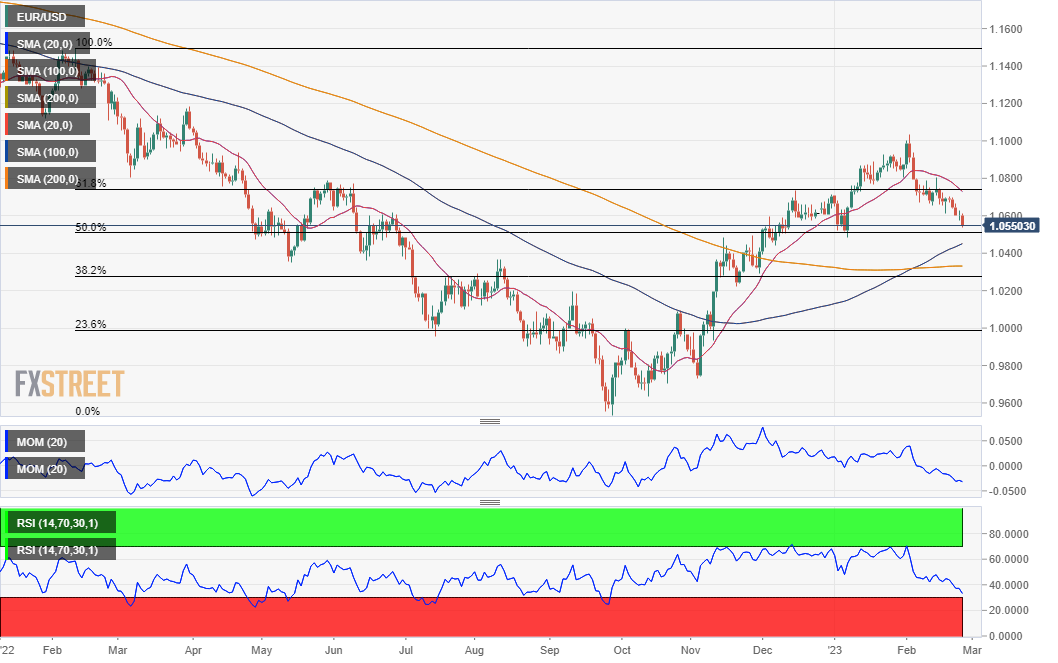- Geopolitical tensions taking their toll on financial markets.
- Hawkish central banks backed by persistent inflation and slower growth.
- EUR/USD selling spiral accelerated ahead of the close and will likely extend next week.
The US Dollar resumed its advance this week, rallying vs all of its major rivals and pushing EUR/USD down to fresh February lows. The USD benefited throughout the first half of the week from a risk-averse environment amid geopolitical tensions between Russia and Western nations. Additionally, hawkish United States Federal Reserve (Fed) messages fueled demand for the Greenback, whilst European Central Bank (ECB) officials were also out with combative words.
Global tensions undermine the mood
A year after Moscow launched its invasion of Ukraine, the world continues to suffer from the side effects of the war. US President Joe Biden unexpectedly visited Kyiv and pledged to support the country. It did not take long for Russian President Vladimir Putin to respond, as he announced the suspension of the nuclear arms treaty with America.
Furthermore, the usually sensitive US-China relationship came under scrutiny after the US shot down what Beijing claimed were weather balloons overflying US space. Tensions arose after Deputy Secretary Antony Blinken called China “irresponsible,” while his Chinese counterpart called the American reaction “hysterical.” Tensions escalated as China’s top diplomat, Wang Yi, visited Moscow to reaffirm the bilateral relationship with Putin.
Beyond the diplomatic conflict, the war has led to massive increases in energy prices, which ended up affecting mostly the Eurozone (EU), as the region depends on Russian oil and gas. Europe has so far bared up quite well with a mild winter, but as the war extends in time, the potential of a steeper economic setback in the EU increases.
US Federal Reserve´s and European Central Bank's hawkish stances
The Federal Open Market Committee (FOMC) released the Minutes of the latest meeting on Wednesday, definitely skewing the scale to the US Dollar side. The document showed that “a few” voting members favored a 50 basis points (bps) rate hike in early February, although they finally delivered a 25 bps one.
The document was read as more hawkish than anticipated, as the meeting took place before the release of the higher-than-expected Consumer Price Index (CPI) data. Policymakers expressed their concerns about upside risks for inflation while adding a tight job market contributes to upward pressures. Additionally, some participants saw an elevated prospect of a recession in 2023. Finally, they believe that it would take some time for inflation to fall to target and that a restrictive monetary policy would be needed until they are confident it will be at 2%. It is worth adding policymakers are optimistic about easing price pressures.
Opposing the US Federal Reserve, the European Central Bank (ECB) President Christine Lagarde commented this week that underlying price pressures remained “alive and kicking,” reaffirming the central bank’s decision to hike rates by 50 bps in March. However, market players are still discounting a possible pause afterwards, as Lagarde & co clarified upcoming decisions will be data-dependant.
Bundesbank President Joachim Nagel repeated Lagarde’s hawkish remarks on Friday, saying he expects a robust rate hike in March while adding that the ECB may still need to proceed with significant rate hikes afterwards.
Worrisome inflation and growth figures
Macroeconomic data took its toll on the Euro while fueling the risk-averse mood. S&P Global unveiled the preliminary estimates of the February PMIs. European manufacturing indexes missed expectations, although services output improved by more than anticipated. In the US, the outcome of both indexes was above the market’s forecast, although manufacturing activity held within contraction territory.
Germany downwardly revised its Q4 Gross Domestic Product (GDP) with the annual pace of growth at 0.9% down from 1.1% previously estimated. Inflation in the country was confirmed at 9.2% YoY in January according to the Harmonized Index of Consumer Prices (HICP). Eurozone HICP, on the other hand, was confirmed at 8.6% YoY, although the core reading was upwardly revised to 5.3%.
US data was quite shocking. On the one hand, the second estimate of the Q4 GDP showed that the annual pace of growth was downwardly revised from 2.9% to 2.7%. More relevantly and in the same quarter, Personal Consumption Expenditures Prices were up by 3.9%, higher than the 3.5% previously estimated.
The United States released the January Personal Consumption Expenditures (PCE) Price Index on Friday, which rose 5.4% YoY and 0.6% MoM, surpassing expectations. The US Federal Reserve’s favorite inflation gauge, the core PCE Price Index, rose 4.7% YoY. The report came in line with the Fed’s hawkish view of inflation still needing time and efforts to fall back to 2%. As a result, high-yielding assets plummeted and the US Dollar made another leg higher ahead of the weekly close.
The upcoming week will bring January US Durable Goods Orders, and the final estimates of S&P Global PMIs for all major economies. Meanwhile, Germany and the EU will publish the preliminary estimates of their February HICP. In between, the US will release the February ISM Manufacturing PMI on Wednesday, and the Services PMI on Thursday.

EUR/USD technical outlook
The EUR/USD pair trades in the 1.0530 area head of the close, and has room to extend its slump. The weekly chart shows that the pair is quickly approaching the 50% Fibonacci retracement of its 2022 yearly decline at 1.0515, a static support level. Repeated daily failure to overcome the 61.8% retracement at 1.0745 over the last few weeks discouraged bulls.
In the aforementioned time frame, a bullish 20 Simple Moving Average (SMA) nears the static support level, reinforcing its relevance and making a break below it a stronger signal for a bearish mid-term run. Technical indicators, in the meantime, have extended their vertical slopes within positive levels and are getting closer to their midlines, reflecting increased selling interest.
Technical readings in the daily chart support a downward extension, particularly if 1.0515 gives up. A bearish 20 SMA has accelerated south well above the current level and is currently piercing the immediate Fibonacci resistance. The Momentum indicator hovers directionless within negative levels, but the RSI indicator heads firmly lower at around 33, anticipating further slides.
Once below 1.0515, a bullish 100 DMA provides dynamic support at around 1.0440. The next relevant level to watch is the 38.2% retracement of the 2022 decline at 1.0280. The first line of sellers is at 1.0620, with a non-too relevant resistance at 1.0680. Above the latter, 1.0745 is the next level to watch.
EUR/USD sentiment poll
The FXStreet Forecast Poll shows that market players weren’t expecting such US Dollar strength, as most remain bullish in EUR/USD. The average target for the next week is at 1.0588, although as time goes by the average increase. Bulls are the shyest in a one-month perspective, as they account for 43% of the polled experts. In the same time frame, however, bears stand at 19%.
The Overview chart shows that the near-term moving average remains directionless, as the spread of potential targets is quite even. The monthly MA turned south, although there is no clear accumulation but around the current level. Finally, the quarterly perspective shows that bulls are still betting for a retest of the 1.1000 price zone and even higher levels are on the table.

Information on these pages contains forward-looking statements that involve risks and uncertainties. Markets and instruments profiled on this page are for informational purposes only and should not in any way come across as a recommendation to buy or sell in these assets. You should do your own thorough research before making any investment decisions. FXStreet does not in any way guarantee that this information is free from mistakes, errors, or material misstatements. It also does not guarantee that this information is of a timely nature. Investing in Open Markets involves a great deal of risk, including the loss of all or a portion of your investment, as well as emotional distress. All risks, losses and costs associated with investing, including total loss of principal, are your responsibility. The views and opinions expressed in this article are those of the authors and do not necessarily reflect the official policy or position of FXStreet nor its advertisers. The author will not be held responsible for information that is found at the end of links posted on this page.
If not otherwise explicitly mentioned in the body of the article, at the time of writing, the author has no position in any stock mentioned in this article and no business relationship with any company mentioned. The author has not received compensation for writing this article, other than from FXStreet.
FXStreet and the author do not provide personalized recommendations. The author makes no representations as to the accuracy, completeness, or suitability of this information. FXStreet and the author will not be liable for any errors, omissions or any losses, injuries or damages arising from this information and its display or use. Errors and omissions excepted.
The author and FXStreet are not registered investment advisors and nothing in this article is intended to be investment advice.
Recommended Content
Editors’ Picks

EUR/USD holds gains below 1.1000 ahead of US CPI release
EUR/USD is tirmimng gains while below 1.1000 in the European session on Thursday. The Euro gains on the German coalition deal and Trump's 90-day pause on reciprocal tariffs. Meanwhile, the US Dollar finds demand on profit-booknig ahead of the US CPI data release.

GBP/USD trades firm above 1.2850, US CPI data awaited
GBP/USD sustained the rebound above 1.2850 in European trading hours on Thursday. The British Pound capitalizes on risk appetite, courtesy of Trump's tariff pause, allowing the pair to recover ground. But further upside hinges on the US CPI data and US-Sino trade updates.

Gold price eases from weekly top amid risk-on mood; still well bid above $3,100 ahead of US CPI
Gold price trims a part of its strong intraday gains to a one-week high touched during the early European session on Thursday and currently trades just above the $3,100 mark. Concerns about escalating US-China trade tensions, along with fears about a tariffs-driven economic slowdown, turn out to be key factors that continue to underpin the safe-haven bullion.

XRP back above $2 liquidating $18M in short positions, will the rally continue?
Ripple seeks support above $2.0020 on Thursday after gaining 14% in the past 24 hours. The token trades at $2.0007 at the time of writing, reflecting growing bullish sentiment across global markets.

Tariff rollercoaster continues as China slapped with 104% levies
The reaction in currencies has not been as predictable. The clear winners so far remain the safe-haven Japanese yen and Swiss franc, no surprises there, while the euro has also emerged as a quasi-safe-haven given its high liquid status.

The Best brokers to trade EUR/USD
SPONSORED Discover the top brokers for trading EUR/USD in 2025. Our list features brokers with competitive spreads, fast execution, and powerful platforms. Whether you're a beginner or an expert, find the right partner to navigate the dynamic Forex market.
